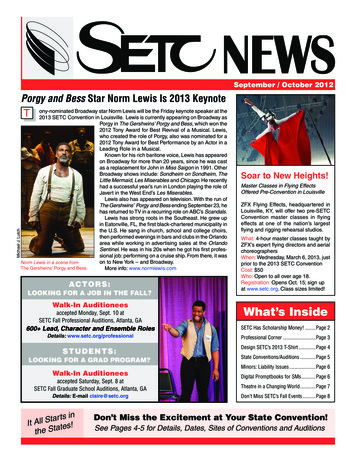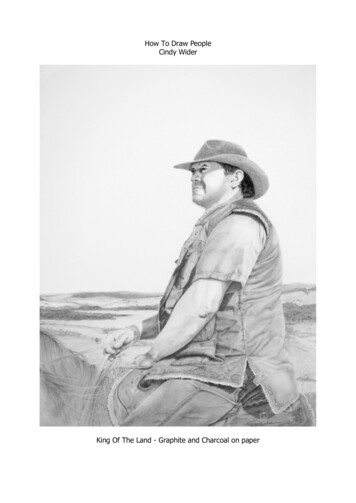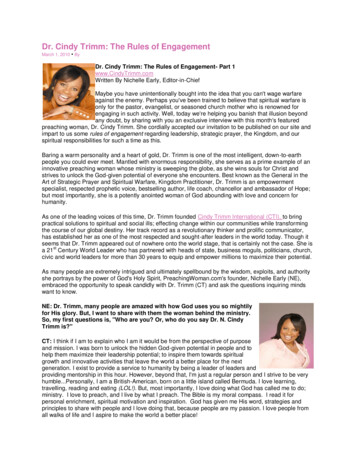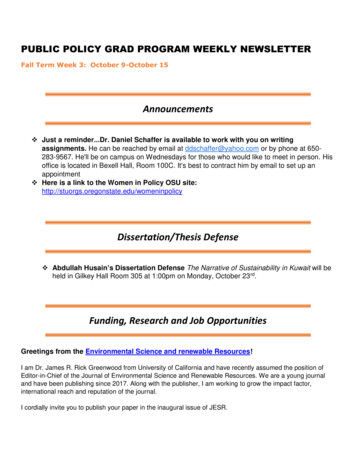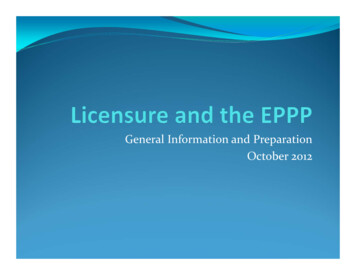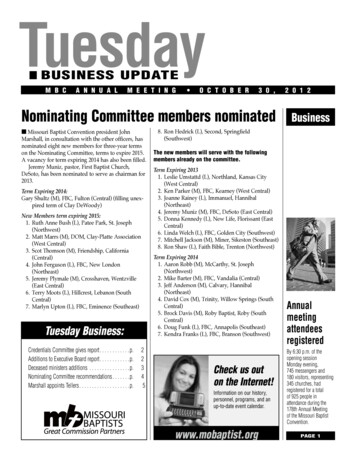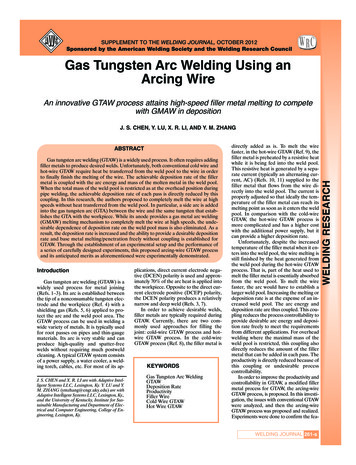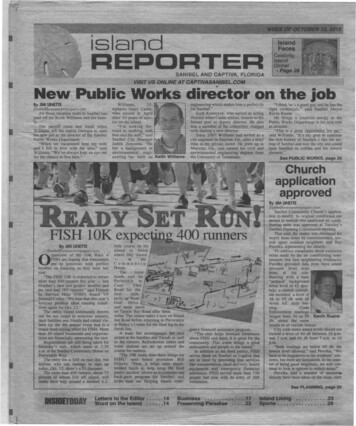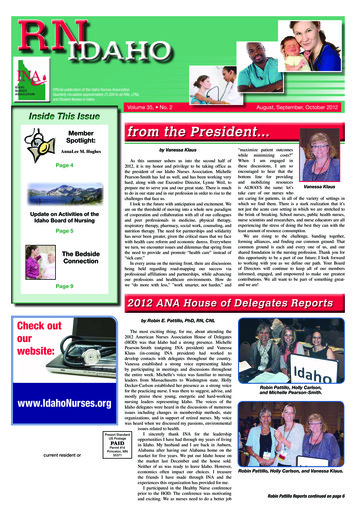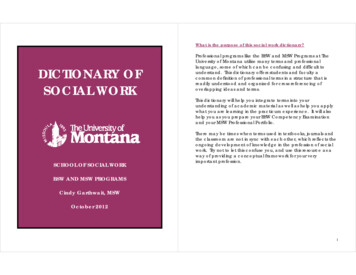
Transcription
What is the purpose of this social work dictionary?DICTIONARY OFSOCIAL WORKSCHOOL OF SOCIAL WORKProfessional programs like the BSW and MSW Programs at TheUniversity of Montana utilize many terms and professionallanguage, some of which can be confusing and difficult tounderstand. This dictionary offers students and faculty acommon definition of professional terms in a structure that isreadily understood and organized for cross referencing ofoverlapping ideas and terms.This dictionary will help you integrate terms into yourunderstanding of academic material as well as help you applywhat you are learning in the practicum experience. It will alsohelp you as you prepare your BSW Competency Examinationand your MSW Professional Portfolio.There may be times when terms used in textbooks, journals andthe classroom are not in sync with each other, which reflects theongoing development of knowledge in the profession of socialwork. Try not to let this confuse you, and use this resource as away of providing a conceptual framework for your veryimportant profession.BSW AND MSW PROGRAMSCindy Garthwait, MSWOctober 20121
¾ Several sections in the dictionary are expanded andorganized in such a way as to show the relationshipbetween concepts and definitions. The following sectionswill be especially helpful in bringing together thesesometimes abstract terms and how to use themprofessionally.How is the dictionary organized?¾ There are two sections to this dictionary, including:1. Social Work Academic Terms¾ Conceptual frameworksThis section defines and describes commonly used termsin social work education and practicum.¾ Group work¾ Evaluation of practice2. Social Work Practice Terms¾ InterventionThis section defines and describes commonly used termsin social work practice in real client situations.¾ Interviewing / counseling¾ Levels of practice¾ A number of terms and groups of terms are crossreferenced in the dictionary, which will help you understandsimilar terms and how some terms relate to each other.¾ Organizations¾ Orienting / explanatory theories¾ Practice theories / models¾ Professional perspectives¾ Research¾ Social work roles¾ Theory23
BSWSection 1Social Work AcademicTermsBachelors (baccalaureate) of social work.BSW Program DirectorFaculty member responsible for the administration of the BSW Program.BSW Student HandbookThe compilation of School of Social Work policies, procedures, guidelines, andcurriculum description for BSW ments/BSWStudentHandbook 2010-2011.pdfChair of School of Social WorkThe faculty member responsible for the administration of the BSW and MSWprograms at the School of Social Work.Academic advisorFaculty member responsible for meeting with individual students to provideacademic planning and mentoring.CitationWritten documentation of the source of content or quotes included in anacademic assignment, following the APA style of writing and documentation.Improper citation, including representing another’s work as one’s own, isconsidered plagiarism.Academic misconductThe violation of the UM Student Conduct Code in regard to academics,including (1) plagiarism, (2) misconduct during an examination or academicexercise, (3) unauthorized use or possession of examination, (4) tampering withcourse materials, (5) submitting false information, (6) cheating, (7) submittingwork from previous courses, (8) inappropriately influencing conduct to obtaingrade. http://life.umt.edu/vpsa/student conduct.phpAccreditationRecognition and certification of a school of social work by the Council on SocialWork Education, providing students a degree that will be recognized by statelicensing authorities and that educates students in line with accreditationguidelines for BSW and MSW programs.Agency field instructorSocial worker within a practicum agency assigned to provide or arrange for theday-to-day supervision of practicum students and to evaluate studentperformance in coordination with faculty supervisor.CompetencyPossession of the knowledge, skills, and values necessary for social workpractice, as measured against the University of Montana School of Social WorkCompetency Catalogue, NASW standards for practice, and Council on SocialWork Education’s Educational Policies and Academic Standards corecompetencies.Competency examinationThe written summative paper completed by students that integrates classroomlearning with practicum experiences, done during both semesters of practicum,and accounting for half of the weight of the overall practicum grade.Continuing educationThe requirement by professions that licensed professionals continue to receivetraining and education to further their professional knowledge and skills,described in written guidelines that vary by state. In Montana, licensed socialworkers must complete 20 hours of continuing education units (CEU’s) per year.APA style of documentationThe style of academic writing and documentation of the AmericanPsychological Association and required by the School of Social Work.Council on Social Work EducationThe accrediting body for both BSW and MSW programs nationwide.Bloom’s Taxonomy of LearningA classification of levels of learning from memorization of information to theutilization, integration, synthesis and critique of informationFaculty supervisorFaculty member assigned to provide academic supervision to practicumstudents, in coordination with the agency field instructor.45
PracticumThe internship (BSW 450 hours, MSW 900 hours)completed during the senioryear that provides students with learning agreements, faculty and social worksupervision, and integrative experiences that prepare graduates for entry levelsocial work practice.Foundation coursesRequired courses for the BSW program, including SW 100, SW 200, SW 300, SW310, SW 350, SW 360, SW 400, SW 487, SW 488, and SW 489.InternshipPlacement in a social services agency that provides experiential learning andacademic credit for students in their freshman, sophomore, or junior years. SW198 or SW 398.Practicum CoordinatorFaculty member responsible for the administration of the practicum program,assisted by the Assistant Practicum Coordinator.MSWMaster of Social WorkMSW Student HandbookThe compilation of School of Social Work policies, procedures, guidelines, andcurriculum description for MSW ional PortfolioThe summative, integrative assignment for MSW students which demonstratestheir academic learning and its application to integrated practiceUM Student Conduct CodeThe written rights and responsibilities of students at The University of Montana,and the policies governing student academic and nonacademic conduct.MSW Program DirectorFaculty member responsible for the administration of the MSW Program.Montana Board of Social Work ExaminersThe state board under the Montana Department of Labor responsible for thelicensing of social workers in Montana.http://bsd.dli.mt.gov/license/bsd boards/swp board/board page.aspMontana –National Association of Social WorkersThe Montana Branch of the NASW, located in Helena, Montana.http://www.naswmt.orgNASW Code of EthicsThe written guide for ethical behavior for social workers, published by theNational Association of Social Workers.PlagiarismThe representation of another’s work as one’s own, or the inadequate citing ofsources.Practice courseA social work course that prepares students for generalist practice, including SW200, SW 350, SW 360.67
Advance directivesWritten guidelines regarding end of life care developed by a client whilecompetent. This term can include living wills and the designation of a healthcare representative to make medical decisions for the client if needed.Section 2Social Work Practice TermsAdvisory boardSee organizationAdvocacyRepresenting others individually or in groups in order to protect them oradvance their causeAgency policies and proceduresThe written guidelines of an agency that describe the ways in which services willbe provided, and which provides guidelines that dictate certain processes thatwill be used.Absolute povertyThe lack of income and/or assets which prevents one from obtaining asubsistence level of functioningAssessmentThe process of examining a problem to determine its cause, severity, and coursewhich is necessary to design an effective intervention plan. Assessment is doneat all levels of practice.ACSW (Academy of Certified Social Workers)A credential offered by the National Association of Social Workers based onmeeting a set of criteria for advanced practiceAttachment disorderInability to form emotional bonds with caretakers, often the results of negativeearly childhood experiences.AccessibilityThe opportunity to obtain or receive servicesAction research (see research)Active listeningThe process of attending to a client through the use of clinical skills in order tounderstand the client’s concernsActivistA social worker or other person whose goal is to achieve social changeBehavioral modelThe practice theory / model based on learning theory which focuses on theprocess of shaping and changing behavior through the use of rewards andreinforcementActivities of daily livingBasic self care activities that allow an individual to live independently, includingbathing, eating, and toileting.See instrumental activities of daily livingBehavioral rehearsalDemonstration of a desired behavior by a social worker or therapist, followed byrole play and rehearsal of the behavior which can then be employed in real lifesettings and situationsAdult Protective Services (APS)The system of services provided to adults vulnerable to abuse, exploitation, orneglectBehavioral theoryOrienting / explanatory theory in which human behavior and development areseen as responses to antecedent stimuli and consequences, both positive andnegative89
BenchmarkA standard of performance against which to measureBeneficenceThe desire to act for the benefit and welfare of othersBenign neglectWithholding help based on a belief that harm may be caused by providing suchhelpBiasNegative attitudes or beliefs about individuals or groupsBio-psycho-social theoryOrienting / explanatory theory about how holistic theory of human developmentthat attempts to explain the ways in which biological, psychological, and socialdevelopment are interactive in terms of influencing developmentBlock grantA practice of allowing a community or state to determine how best to use ablock of fundingBoard of directorsThe policy-making committee that is responsible for the operation of anorganization in terms of funding, staff, mission, and programs. See organizationBrawner RuleThe standard by which a person is deemed to be not guilty by reason of insanity,including the inability to behave in accordance with law or understand thathis/her conduct is wrongBrief therapyPsychotherapy practiced for a limited number of sessions and with clear goalsand objectivesBrokerA professional role played by a social worker by which clients, families, groups ororganizations are linked in order to receive services or support each otherCapacity buildingProcess of developing the abilities, attributes, resources and will to set and reachgoals by a client, group, organization, or communityCase findingProcess of seeking out persons eligible to receive services provided by anagency, often done through outreach activitiesCase managementSecuring, implementing, and monitoring services needed by a clientCase managerSocial worker whose role is to oversee and coordinate a client’s services inkeeping with the client’s goals and needsCaseloadThe group of clients or client systems for which a social worker is responsible toserveCentralizationThe consolidation of power in an organization that has administrativeresponsibility for its operationChange agentA social worker working toward change at the micro, mezzo or macro level ofpracticeChaos theoryOrienting / explanatory theory that describes how rapid and sudden changesmay occur in social systems, may appear to be chaotic and random, but maybe the result of positive feedback loops (both positive and negative) andchange efforts that suddenly impact the entire social system and creativechangeChild Protective Services (CPS)The system of services provided to children and youth vulnerable to abuse,neglect, exploitation or neglectBureaucracySee organizationChild welfareThe field of practice responsible for monitoring and promoting the rights andwelfare of children and youth1011
Cognitive behavioral modelThe practice theory / model based on behaviorism and social learning theorythat helps clients recognize the impact of self-defeating or erroneous cognitivebeliefs or perceptions on their behaviorCivil rightsRights of citizens given by a government that protect them from abuse byindividuals, organizations, social policies, or governmentsClassismNegative stereotyping about people based on their socioeconomic statusClientCognitive dissonanceThe simultaneous existence of contradictory beliefs and actions which cancause discomfort and lead the individual to change either the behavior or thebeliefMicroIndividual or family which is seeking or being provided social servicesMezzoGroup, organization or community that is seeking or being provided socialservicesMacroSociety, social policy, social change, or research as the entity beingserved or targetedClient systemThe client and the facets of the client’s social environment which impact theclient and which are the target of social work interventionCognitive restructuringThe therapeutic process of assisting an individual to see cognitive errors and selfdefeating beliefs and develops more positive thoughts and beliefsCohortA group of people who were born at approximately the same time and/or whoshare a certain characteristic or experienceCommunityA group of individuals, families, or groups that share geographic location,identity, values, experiences or interestsClient centered modelThe model of social work practice that assumes clients are capable of dealingwith their problems in social functioning, and in which the social worker partnerswith the client to encourage him/her to take the lead in devising interventionsCommunity organizationAn area of social work which focuses on social change within a communitybased on an identified needCompetencyPossession of the knowledge, skills, and values necessary for social workpractice, as measured against the University of Montana School of Social WorkCompetency Catalogue, NASW standards for practice, and the Council onSocial Work Education’s Educational Policies and Academic Standards corecompetencies.Closed systemA social system that is not open to feedback or input from other sources, hasrigid boundaries, is self-contained, and tends to resist changeCode of ethicsA written set of ethical and value-based principles for a profession, providingguidance in ethical decision-making. The National Association of SocialWorkers’ Code of Ethics guides the social work profession in terms of ethics.Co-dependencyA relationship between people that is generally considered an unhealthy way ofmeeting the individual emotional and social needs of those in the relationshipCognitionThe intellectual process of dealing with information, including understanding,processing, remembering, and evaluatingConceptual frameworkA way of organizing ideas, concepts, and theories of social work practice.Includes perspectives, orienting / explanatory theories, and practice theories /modelsConduct disorderA disorder usually found in children and youth in which there is repetitive andconsistent behavior that violates the behavioral norms and values for that agegroupConfidentialityThe ethical stance that a professional can only release or share informationabout a client with their consent1213
Conflict of interestA conflict between a professional’s personal and private interests that mayimpact practiceCost benefit analysisThe weighing of the costs and resources associated with providing a serviceagainst the benefits or providing that serviceConflict theoryOrienting / explanatory theory which states that individuals and social systemsare often in conflict, and this conflict between and within families, groups,communities and other social systems impacts human behavior anddevelopmentCost sharingThe division of financial responsibility for a program between two or moreorganizations or entitiesCounselingSee interviewing/counselingConsensus approachThe process of coming to agreement about issues and approaches for dealingwith them. Arising from the feminist perspective on social work practice,consensus organizations are those which commit to consensus, in at least ageneral sense, in order to share power and commit to a course of action as agroup. See organization.ConservatismThe political belief in traditional values, societal structures and mores thatcommonly lead to a commitment to decreasing governmental influence in andfunding for public issues and programsConstituencyA group of people, including clients, customers, or citizens who are representedor served by a social program or an elected officialContinuing education unitsThe requirement by professions that licensed professionals continue to receivetraining and education to further their professional knowledge and skills,described in written guidelines that vary by state. In Montana, licensed socialworkers must complete 20 hours of continuing education units (CEUs) every year.Continuum of careThe spectrum of services available to clients which should ideally fill all gaps andminimize duplicationControl groupSee researchConstruct validitySee researchCounter-transferenceEmotional reactions by a professional toward a client that originate in theprofessional’s personal experience and which may be projected onto a clientCrisis intervention modelThe practice theory / model which focuses on helping clients deal withoverwhelming crisis situations by drawing upon their strengths and resources toget them through the crisis and return to a normal level of functioning, and inwhich a professional may take a more directive role because of the client’sinability to proceedCrisis theoryOrienting / explanatory theory about how individuals and families whoexperience significant crises may exhibit fairly predictable behaviors, responsesand patterns of recoveryCritical incident stress debriefingThe process of debriefing with those who have experienced a crisis, conductedwith the goal of allowing individuals and groups to express their feelings, gainsupport, and use coping skills to deal with the crisis. Often done withprofessionals who have experienced a trauma or crisis in their work.Critical theoryThe orienting / explanatory theory that critiques positivism as the only acceptedway of knowing, questions underlying assumptions of individual, theoretical andscientific understandings, recognizes structural and political contributors tosocial problems and oppression, and suggests that personal choice and powercan transform the social environmentCross cultural competenceThe ability to be knowledgeable about, accepting of, and empathetic withdiverse clients and populations, resulting in culturally appropriate and effectiveassessment and interventions.Co-paymentThe amount a client needs to pay for a service covered by insurance,sometimes a percentage of the total cost and sometimes a specified dollaramount1415
DeconstructionAnalysis of theories and models that involves examining and questioning thebeliefs, values, and assumptions of those theories or models, allowing forcritique, clarification, and revisionCultureCustoms, beliefs, ideology, world-view, and values common to a group ofpeople and which guide their individual and social behavior.Cultural theoryOrienting / explanatory theory about how individuals and groups whichexperience oppression or discrimination will be impacted in their developmentby these experiences, both positively and negativelyDeductibleThe amount an individual is required to pay for a health or other insurance claimbefore the insurer pays their share of the claim.Culture of povertyThe belief that poverty is perpetuated because poor people’s values,experiences, and motivations prevent them from becoming financiallyindependent.Defense mechanismThought processes, often considered to be unconscious and which serve toshield individuals from powerful negative emotions, including denial,rationalization, projection, minimization, and intellectualizationCustodyThe legal right to protect, make decisions for, and be a guardian for anindividual who is deemed incapable of living independently.DeinstitutionalizationThe practice of returning institutionalized individuals to the community to receiveservices or to function on their own.Cycle of change theory (Prochaska and DiClemente)The orienting / explanatory theory on individual change which posits thatpeople change in a cyclical way rather than a linear one, that the stages ofchange are distinct from each other, and that relapse is common. TheMotivational Interviewing practice theory / model is built upon the cycle ofchange theory.Delphi methodA method of research for social planning that uses a survey / questionnaire witha group of experts in order to determine the feasibility and potential impact of aproposed interventionDelusionAn erroneous belief that persists despite evidence to the contrary. Examplesinclude delusions of grandeur and persecution. See also hallucination.Dependent variableSee researchDesensitizationA systematic process of exposing an individual to stimuli or experiences thatcause anxiety, with the idea that exposure will lessen anxiety and fear.DecentralizationThe practice of distributing power to those who are closely involved with theissue at hand rather than delegating power to the upper levels of anorganizationDevelopmental disabilityA condition that is congenital or that is exhibited before adulthood that limits anindividual’s ability to function independently. This condition may be genetic ora result of disease or other causation.Decision treeA process of using yes and no questions to make a decision, whereby a yesanswer leads the respondent to a different series of questions than does a noanswer.Developmental theoryThe orienting / explanatory theories at the micro, mezzo and macro level ofpractice that suggest that individuals, families, groups, communities, societies,and social policies proceed through somewhat predictable stages in theirongoing developmentDecompensationThe gradual or rapid decline in the level of an individual’s mental functioningand cognitive processing1617
DiagnosisThe process of identifying a condition and assessing the causes and contributorsto that condition, based on symptoms and course, and allowing for a plan ofcare.Diagnosis of convenienceThe process of assigning an inaccurate or minimally accurate diagnosis to aclient in order to receive insurance payments because insurance companiesmay ay only for certain diagnosed conditions.DisenfranchisementThe real or felt experience of not having the power or ability to exercise one’srightsDisregardsThe process used by a funding source to not count certain income or assetswhen determining eligibility for services or benefitsDisposable incomeAvailable funds after all expenses are paidDSM (Diagnostic and Statistical Manual)The manual of the American Psychiatric Association which describes andclassifies mental disorders based on prescribed symptoms, severity, and length.Clients are assessed on Axis I (syndromes or conditions not related to mentalillness), Axis II (personality disorders and mental retardation), Axis III (physicaldiseases and conditions), Axis IV ( psychosocial and environmental problems),and Axis V (global assessment of functioning).Double blindSee researchDual diagnosisTwo co-existing, overlapping, and mutually interacting conditions. Also referredto as co-existing disorders or co-morbidity.Dual relationshipThe co-existence of a professional and personal role between a social workerand client, often considered to be unethical because of the power differentialbetween social worker and client.Differential diagnosisDiagnosis of disorders or social issues by analyzing and comparing thecharacteristics of similar conditions.Discharge planningProcess of planning for the discharge and placement of an individual followinghospitalization or residential care that allows for a smooth transition andwhatever supports will be needed to maintain the client’s level of functioning.Due processThe practice of ensuring rights, fair processes, and adherence to laws when anindividual is accused of misconduct or a crimeDiscouraged workerAn unemployed individual who has ceased seeking employment followingunsuccessful attempts to find employment, and who is not usually counted inlabor statistics related to unemployment.Durable power of attorneyA legal document / process by which an individual gives another individual thelegal power to make decisions on his/her behalf should that individual becomeincompetent or incapacitated.DiscriminationThe practice of treating people differently and negatively based on adifference such as gender, age, religion, political orientation, sexual orientation,or ability.Duty to warnThe legal obligation to report a client’s threats or danger to another personbased on the Tarasoff ruling of 1976Disease theory / medical theory of human developmentOrienting / explanatory theory which focuses on human development asprimarily a result of internal factors, including genetics, personality traits,biological conditions, and other individual factors. It also posits that there is aset of symptoms for conditions, a predictable course for the disease, and agenerally agreed-upon protocol for treatment1819
Ethical dilemmaA situation in which two strongly held values are in conflict, and in which actionto support one value violates the other.Ecosystems / ecological perspectiveProfessional view of clients / client systems in which the interaction between theclient and the social environment is examinedEfficacyBelief in one’s ability to be effective and capableEligibility criteriaThe qualifications and specific requirements utilized to determine if one is eligibleto receive benefits or servicesEmpathyThe therapeutic technique of communicating to a client that their situation,reactions, and emotions are appreciated and understood, which builds rapportand sets the foundation for a helping relationshipEmpowerment modelIntervention needs to employ methods that encourage individuals and familiesto recognize, claim, and use their power to enhance the quality of their livesEnablerThe social work role of assisting a client to attain the ability to deal with issuesand situationsEthics auditA process by which the values and ethics underlying an organization andplayed out in real life situations are assessed, evaluated and monitored againstthe NASW Code of Ethics, for the purpose of ensuring ethical treatment of allclients.Ethics committeeA group of individuals within an organization given the responsibility to analyzeand make recommendations or decisions in situations in which expert ethicaldecision-making is required or when ethical dilemmas are present.Evidence based practiceProfessional practice based on empirical studies of practice approaches andmodels, combined with professional ethics, best practices, and practicewisdom.EtiologyThe underlying causes of a social problem, condition, or behaviorEvaluation of practiceSystematic analysis of the effectiveness of an intervention, program, or policy,conducted at all levels of practiceMicro level practice examplesEvaluation of individual and family changeEvaluation of social worker effectivenessEndowmentA fund that is built on donations and fund-raisers that is permanent and whichproduces income based on investments and / or interest.Mezzo level practice examplesEvaluation of group or organization change effortsEvaluation of social worker effectivenessEntitlementFunds or services for which individuals qualify based on their membership in aparticular classification or their statusEquilibriumThe tendency of a social system to maintain balance, and which can be eitherpositive or negativeMacro level practice examplesEvaluation of program effectiveness, community change efforts, andpolicy change effortsEvaluation of social worker effectivenessProcess versus outcome evaluationThe form of evaluation that analyzes the step-by-step actions taken in anintervention for their effectiveness as compared to the identifiable resultsof an intervention, both of which are necessary in evaluation orinterventions.Erikson theory of psychosocial developmentOrienting / explanatory theory that outlines general stages of psychosocialdevelopment for age / life stages2021
Qualitative versus quantitative evaluationThe form of evaluation that analyzes the subjective, individual, and nonquantifiable aspects of intervention compared to the form of evaluationthat measures and describes the quantifiable aspects of interventionFamily reunification modelApproach that offers services to families who have been separated and / oralienated in order to reconstitute them as a family with the resources and skills toaddress their problems as a familyFamily systems theoryOrienting / explanatory developmental theory that focuses on the mutualinteractions between parts of the family and which forms the basis for familysystems interventionsExternal locus of controlThe belief that one’s situation is controlled by external forces and that one’spersonal ability or power to change a condition is limited or non-existentFeasibility studyFormal assessment of an organization or community’s ability to complete acertain objective or task, including the resources required to do thisFee for serviceThe charges to a client / client sys
Psychological Association and required by the School of Social Work. Bloom’s Taxonomy of Learning A classification of levels of learning from memorization of information to the utilization, integration, synthes is and critique of information Section 1 Social Work Academic Terms 5 BSW Bachelors (baccalaurea
